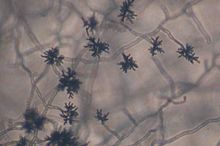 Every time you inhale, you suck in thousands of microbes. And depending on where you live, the microbes will vary. From Wired:
Every time you inhale, you suck in thousands of microbes. And depending on where you live, the microbes will vary. From Wired:
An Atlas of the Bacteria and Fungi We Breathe Every Day
EVERY TIME YOU inhale, you suck in thousands of microbes. (Yes, even right then. And just then, too.) But which microbes? Scientists mostly assumed that the living components of air—at the tiniest scales, anyway—were the same no matter where you went.
And? Not true, it turns out. Thanks to a 14-month citizen-science project that sampled and analyzed airborne dust around the country, researchers have constructed the first atlas of airborne bacteria and fungi across the continental US. And airborne microscopic life is really diverse.
More than 1,400 volunteers swabbed surfaces in 1,200 houses around the country, focusing on the places people don’t usually clean. The dust there passively collects microbes. In the end those swabs revealed about 112,000 bacterial and 57,000 fungal phylotypes (i.e. familial groups).
Most of these little guys were harmless. The few pathogens and allergens ended up being location-specific. Alternaria, a fungal genus that’s also a common allergen, is ubiquitous but concentrates most in the midwest. The fungus Cladosporium has smaller hotspots scattered all over the country east of Texas, most frequently in the South and Mid-Atlantic. Meanwhile, the bacterial genus Cellulomonas, an normally harmless microbe (but an emerging pathogen according to one study), is much more common in the west.
The two biggest factors that shape this airborne environment, according to study author and University of Colorado microbial ecologist Noah Fierer, are the types of soil and plants that are located in the area (affecting the acidity in the environment), and the climate (humidity, temperature, etc.) Cities, for example, tended to be more like other cities than the rural areas nearby, which Fierer attributes to urban areas tending to plant the same types of trees and flowers and playing host to the same types of wildlife (pigeons, rats, etc).
 Clasdosporium is a genus of fungi including some of the most common indoor and outdoor molds. Credit: Wikipedia.
Clasdosporium is a genus of fungi including some of the most common indoor and outdoor molds. Credit: Wikipedia.
